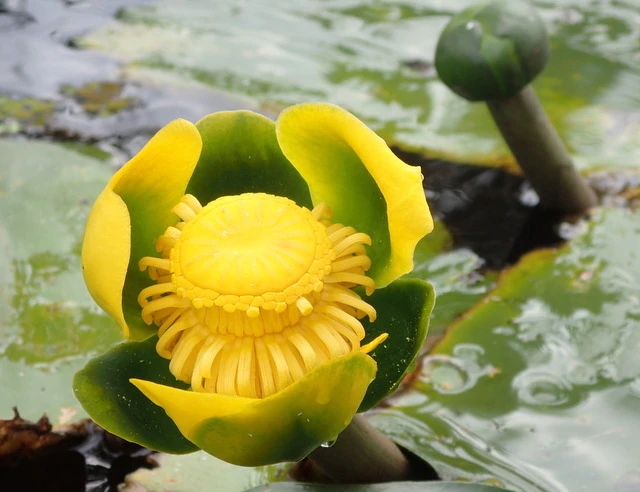Common Spatterdock
(Nuphar advena)
Common Spatterdock (Nuphar advena)
/
/

mfeaver
CC BY 4.0




















































Estimated Native Range
Climate Requirements for Kearns, Utah
| This Plant | Your Site | Plant Suitability for Your Location | ||
|---|---|---|---|---|
| • Precipitation | 14" - 95" | 19" | Your precipitation may be insufficient for this plant. Irrigate N" / year. | Irrigate N" / year |
| • High Temp. | 58°F - 98°F | 92°F | Your summer temperatures are normal for this plant. | Excellent |
| • Low Temp. | -13°F - 64°F | 20°F | Your winter temperatures are normal for this plant | Excellent |
Summary
Common Spatterdock is valued for its ability to provide habitat for aquatic wildlife and for its ornamental flowers that can enhance the natural beauty of water gardens and ponds. It is often used in wetland restoration projects due to its tolerance of fluctuating water levels and its role in stabilizing shorelines. In cultivation, it requires full sun to part shade and thrives in shallow water or muddy soil with poor to moderate drainage. While it is generally low-maintenance, it can spread vigorously in ideal conditions, potentially becoming invasive in some areas. Gardeners should monitor its growth to prevent unwanted spread.CC BY-SA 4.0
Plant Description
- Plant Type: Herb
- Height: 3-4 feet
- Width: 0.375-0.5 feet
- Growth Rate: Moderate
- Flower Color: Yellow
- Flowering Season: Spring, Summer, Fall
- Leaf Retention: Deciduous
Growth Requirements
- Sun: Full Sun
- Water: Aquatic
- Drainage: Standing
Common Uses
Deer Resistant, Edible*Disclaimer: Easyscape's listed plant edibility is for informational use. Always verify the safety and proper identification of any plant before consumption., Fragrant, Low Maintenance, Water Garden
Natural Habitat
Freshwater wetlands, including marshes, slow-moving streams, and pond and lake edges
Other Names
Common Names: Yellow Pond-Lily, Varigated Yellow Pond-Lily, Spatter-Dock, Broadleaf Pond-Lily, Large Yellow Pond-Lily, Spatterdock, Nénufar À Feuilles Émergentes, Nénuphar D’Amérique, Nénuphar À Feuilles Émergentes, Sextalig Näckros
Scientific Names: Nuphar advena, Nuphar lutea subsp. advena, Nuphar advena var. cubana, Nuphar advena subsp. typica, Nuphar advena var. erythraea, Nymphaea advena subsp. erythraea
GBIF Accepted Name: Nuphar advena (Aiton) Aiton